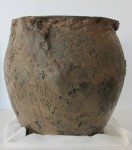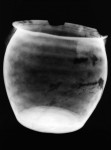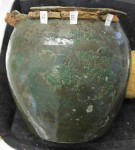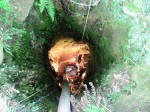 An Etruscan well in Cetamura del Chianti, an archaeological site on the property of the Badia a Coltibuono wine-making estate in Tuscany, has proven a cornucopia of historical artifacts from 300 B.C. through the end of the Middle Ages. The well — which technically is a cistern rather than a well since it isn’t spring-fed but rather a rain catchment shaft — was dug more than 105 feet deep into the sandstone bedrock of the Cetamura hilltop. Over the centuries, a vast number of artifacts made from bronze, silver, lead and iron, plus ceramics, glass, bricks, tiles, wood, 70 bronze and silver coins, jacks-like game pieces (astragali), animal bones, antlers and grape seeds were thrown into the well, probably as votive offerings in antiquity and as simple discards in later eras.
An Etruscan well in Cetamura del Chianti, an archaeological site on the property of the Badia a Coltibuono wine-making estate in Tuscany, has proven a cornucopia of historical artifacts from 300 B.C. through the end of the Middle Ages. The well — which technically is a cistern rather than a well since it isn’t spring-fed but rather a rain catchment shaft — was dug more than 105 feet deep into the sandstone bedrock of the Cetamura hilltop. Over the centuries, a vast number of artifacts made from bronze, silver, lead and iron, plus ceramics, glass, bricks, tiles, wood, 70 bronze and silver coins, jacks-like game pieces (astragali), animal bones, antlers and grape seeds were thrown into the well, probably as votive offerings in antiquity and as simple discards in later eras.
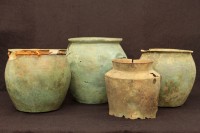 The Cetamura settlement has been excavated since 1973, unearthing Etruscan remains including an acropolis and extensive artisan quarters, a Roman villa and baths and a medieval fort. The well is in Zone 1, the acropolis area on the top of the hill, and a team of archaeologists and students led by Florida State University Etruscan expert Nancy de Grummond have been excavating it since 2011. So far the team has unearthed 14 Roman and Etruscan bronze vessels, an impressive number of very rare Etruscan wood pieces and almost 500 grape seeds.
The Cetamura settlement has been excavated since 1973, unearthing Etruscan remains including an acropolis and extensive artisan quarters, a Roman villa and baths and a medieval fort. The well is in Zone 1, the acropolis area on the top of the hill, and a team of archaeologists and students led by Florida State University Etruscan expert Nancy de Grummond have been excavating it since 2011. So far the team has unearthed 14 Roman and Etruscan bronze vessels, an impressive number of very rare Etruscan wood pieces and almost 500 grape seeds.
The bronze vessels, of different shapes and sizes and with varying decorations, were used to extract water from the well, which has been excavated to a depth of more than 105 feet.
“One of the Etruscan vessels, actually a wine bucket, is finely tooled and decorated with figurines of the marine monster Skylla,” de Grummond said. “Another was adorned with a bronze finial of the head of a feline with the mane of a lion and the spots of a leopard and, for handle attachments, had African heads, probably sphinxes.”
The grape seeds, found in at least three different levels of the well — including the Etruscan and Roman levels — are of tremendous scientific interest, according to de Grummond.
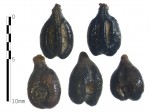 The seeds date to the third and second centuries B.C. (Etruscan) and to the late first century B.C., early first century A.D. (Roman). The waterlogged environment preserved them exceptionally well which will give researchers the rare opportunity to do DNA testing as well as radiocarbon dating. This has the potential to illuminate the viticultural history of one of the famous wine growing regions of the world, a history that is very little known. Genetic and morphometric analyses of the seeds will categorize the different grape varieties and, if all goes well, will determine if any of these ancient Chianti grapes are related to the ones used to make Chianti wines today. The Roman seeds discovered in the 2012 and 2013 dig seasons have already been sorted into three different types.
The seeds date to the third and second centuries B.C. (Etruscan) and to the late first century B.C., early first century A.D. (Roman). The waterlogged environment preserved them exceptionally well which will give researchers the rare opportunity to do DNA testing as well as radiocarbon dating. This has the potential to illuminate the viticultural history of one of the famous wine growing regions of the world, a history that is very little known. Genetic and morphometric analyses of the seeds will categorize the different grape varieties and, if all goes well, will determine if any of these ancient Chianti grapes are related to the ones used to make Chianti wines today. The Roman seeds discovered in the 2012 and 2013 dig seasons have already been sorted into three different types.
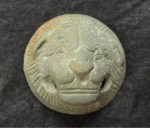 Interestingly, the grape seeds weren’t just thrown in to the well in handfuls. The team found most of them inside the bronze vessels, evidence that they may have been ritual offerings rather than garbage. The wood from the early Etruscan level also appears to have played a ritual role.
Interestingly, the grape seeds weren’t just thrown in to the well in handfuls. The team found most of them inside the bronze vessels, evidence that they may have been ritual offerings rather than garbage. The wood from the early Etruscan level also appears to have played a ritual role.
“Many of the pieces of wood were worked, and already several objects have been identified, such as parts of buckets, a spatula or spoon, a spool and a rounded object that might be a knob or child’s top,” [de Grummond] said. “The sheer amount of Etruscan waterlogged wood — with some recognizable artifacts — could transform views about such perishable items.”
To follow the news from the Cetamura del Chianti well excavation, keep an eye on their Facebook page.
